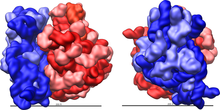Ribosomal DNA (rDNA) is a DNA sequence that codes for ribosomal RNA. Ribosomes are assemblies of proteins and rRNA molecules that translate mRNA molecules to produce proteins. As shown in the figure, rDNA of eukaryotes consists of a tandem repeat of a unit segment, an operon, composed of NTS, ETS, 18S, ITS1, 5.8S, ITS2, and 28S tracts. rDNA has another gene, coding for 5S rRNA, located in the genome in most eukaryotes. 5S rDNA is also present in tandem repeats as in Drosophila. In the nucleus, the rDNA region of the chromosome is visualized as a nucleolus which forms expanded chromosomal loops with rDNA. These rDNA regions are also called nucleolus organizer regions, as they give rise to the nucleolus. In the human genome there are 5 chromosomes with nucleolus organizer regions: the acrocentric chromosomes 13,14,15,21 and 22.
Sequence homogeneity of the repeat unit

In the large rDNA array, polymorphisms between rDNA repeat units are very low, indicating that rDNA tandem arrays are evolving through concerted evolution. However, the mechanism of concerted evolution is imperfect, such that polymorphisms between repeats within an individual can occur at significant levels and may confound phylogenetic analyses for closely related organisms.
5S tandem repeat sequences in several Drosophila were compared with each other; the result revealed that insertions and deletions occurred frequently between species and often flanked by conserved sequences. They could occur by slippage of the newly synthesized strand during DNA replication or by gene conversion.
Sequence divergence to clarify phylogeny

The rDNA transcription tracts have low rate of polymorphism among species, which allows interspecific comparison to elucidate phylogenetic relationship using only a few specimens. Coding regions of rDNA are highly conserved among species but ITS regions are variable due to insertions, deletions, and point mutations. Between remote species as human and frog comparison of sequences at ITS tracts is not appropriate. Conserved sequences at coding regions of rDNA allow comparisons of remote species, even between yeast and human. Human 5.8S rRNA has 75% identity with yeast 5.8S rRNA. In cases for sibling species, comparison of the rDNA segment including ITS tracts among species and phylogenetic analysis are made satisfactorily. The different coding regions of the rDNA repeats usually show distinct evolutionary rates. As a result, this DNA can provide phylogenetic information of species belonging to wide systematic levels.
Notes



0 komentar :
Posting Komentar